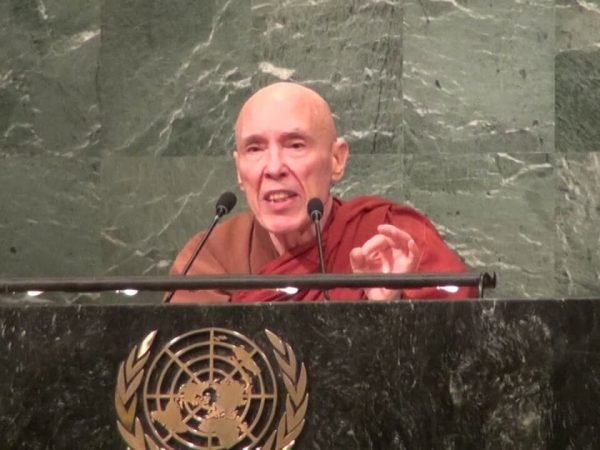Compassion
The Karmapa (2013, p. 92)1Karmapa, H. H. (2013). The heart is noble, changing the world from the inside out. Boston: Shambala Publications. also stated that “the single most important factor that will move us to act to protect the world is compassion.” Compassion is indeed the needed quality to inform one’s attitude when facing the current crisis. In early Buddhist thought, a prominent dimension of compassion is the wish for the absence of any harm (Anālayo 2015)2Anālayo, B. (2015). Compassion and emptiness in early Buddhist meditation. Cambridge: Windhorse Publications https://www.buddhismuskunde.uni-hamburg.de/pdf/5-personen/analayo/compassionemptiness.pdf.. First and foremost, this implies the absence of cruelty in one’s own mind and the avoidance of doing anything harmful to others. But it also covers the wish for others to be free from harm that has not been inflicted by oneself.
The attitude relevant here can conveniently be exemplified with a passage, found in a Pāli discourse and a parallel extant in Chinese, which describes how to avoid resentment toward someone who behaves in thoroughly unwholesome ways. The passage ties in with the observation above that, from an early Buddhist perspective, anger is not an appropriate response. This holds even when another is behaving in ways that are entirely irresponsible and reprehensible.
Instead of dwelling on the pain of the other, the cultivation of compassion takes as its object the potential alleviation of the pain.
The two parallels first recommend that one should avoid resentment toward another who is acting in unwholesome and bad ways by trying to find something good in this person and paying attention to that. However, if the person is entirely evil and nothing good at all can be found, then such a person provides an excellent opportunity for the cultivation of compassion. This is the appropriate response here.
Besides making the important point that the unwholesome and bad conduct of others is no excuse for getting angry, the actual description of the attitude toward such a person provides helpful information about the nature of compassion. The two versions illustrate the arousing of compassion in the following way:
Friends, it is like a person travelling along a main road who is sick, afflicted, seriously ill. The last village is far behind and the next village is far ahead. He would not get appropriate food, he would not get appropriate medicine, he would not get an appropriate nurse, and he would not get someone guiding him to the vicinity of a village. Another person travelling along the main road were to see him and were to arouse compassion, were to arouse sympathy, and were to arouse empathy for this person, [thinking]: ‘May this person get appropriate food, get appropriate medicine, get an appropriate nurse, and get someone guiding himto the vicinity of a village! Why is that? May this person not encounter misfortune and ruin right here!’
It is like a person who is on an extended journey along a long road. Becoming sick halfway he suffers extremely and is exhausted. He is alone and without a companion. The village behind is far away and he has not yet reached the village ahead. Suppose a person comes and, standing to one side, sees that this traveler, who is on an extended journey along a long road, has become sick halfway, suffers extremely, and is exhausted. He is alone and without a companion. The village behind is far away and he has not yet reached the village ahead. [The second person thinks:] ‘If he were to get an attendant, emerge from being in the far away wilderness and reach a village or town, and were to be given excellent medicine and be fed with nourishing and delicious food, be well cared for, then in this way this person’s sickness would certainly subside.’ That is, that person has extremely compassionate, sympathetic, and kind thoughts in the mind towards this sick person.
Both versions do not proceed beyond the point of depicting the mental attitude in response to seeing the sick traveler. This is unsurprising, as the episode is meant to illustrate the appropriate attitude toward someone thoroughly bad and thereby counter potential resentment; it is not meant to describe a course of action to be taken. Had the story been employed in a different context, it would quite probably have continued by showing the compassionate person doing whatever possible to ensure that the sick traveler indeed receives the type of assistance needed. In other words, the fact that the two versions do not report actual assistance rendered to the afflicted person is simply due to the purpose for which the description is being employed.

From the viewpoint of the close relationship between compassion and the wish for the absence of harm, it is significant that the harm in this case has not been inflicted by someone else on the sick traveler. Instead, it is simply due to unfortunate circumstances.
Another point of interest in the above description is that compassion finds expression in the witnessing person’s wish for the sick person to be in some way relieved from misfortune. In other words, although the vision of the ailing traveler’s distress forms the starting point, the actual compassion takes as its main object the idea of the sick person being helped and finding relief. The task is not to keep dwelling on the actual suffering, imagining in detail how it must feel to be sick and helpless in this way. Instead of dwelling on the pain of the other, the cultivation of compassion takes as its object the potential alleviation of the pain.
Mindfulness can be of crucial support, by helping to monitor and adjust in such a way that inner balance can be maintained.
A helpful distinction in this respect can be found in a later text, a practice manual of the Theravāda tradition called the Path of Purification, Visuddhimagga. The passage in question presents a “near enemy” of compassion (Vism 319), in the sense of a quality that, in spite of some superficial similarity, turns out on closer inspection to be inimical to genuine compassion: sadness or grief (domanassa). This needs to be avoided.
The important distinction made in this way is not always evident in later Buddhist traditions, as with some of these a tendency developed to conceptualize compassion as a form of taking on oneself the pain of others (Anālayo 2017)3Anālayo, Bh. (2017). How compassion became painful. Journal of the Centre for Buddhist Studies, Sri Lanka, 14, 85–113 https://www.buddhismuskunde.uni-hamburg.de/pdf/5-personen/analayo/compassionpainful.pdf.. Although certainly a meaningful approach within its particular doctrinal and historical setting, such notions differ from the early Buddhist conception of compassion.
When applied to the current crisis, the compassionate intent to avoid and minimize harm need not result in sadness and grief. In view of the magnitude of the problem, the inertia of major parts of the human population, and the existence of antagonistic forces in leadership positions, sadness and grief can easily arise. This is where mindfulness can be of crucial support, by helping to monitor and adjust in such a way that inner balance can be maintained.
Remaining free from grief and sadness is in fact a key element in the cultivation of the establishments of mindfulness (satipaṭṭhāna/smṛtyupasthāna). In relation to each of the four domains of such practice, which cover the body, feeling tones, mental states, and dharmas, the following qualities should be cultivated:
Being diligent, clearly knowing, and mindful, removing greedy desire and sadness in the world.
Being with diligent effort, right mindfulness, and right knowing, overcoming greed and sadness in the world.
In this way, it is a key aspect of mindfulness practice to ensure that one stays free of grief or sadness. This relies on the potential of mindfulness to be with what is, acknowledging it without either turning away or reacting to it.
The Eightfold Path
The need for inner balance when facing the current crisis requires a skillful interrelation between compassion and mindfulness. How to achieve this can best be appreciated from the viewpoint of the noble eightfold path, a central teaching in early Buddhism. This eightfold path presents in a nutshell the different dimensions or activities whose collaborative cultivation leads to awakening. According to a discourse extant in Pāli, Chinese, and Tibetan, the eight factors of this path build on each other in the following way:
Monastics, in one of right view, right intention comes into being; in one of right intention, right speech comes into being; in one of right speech, right action comes into being; in one of right action, right livelihood comes into being; in one of right livelihood, right effort comes into being; in one of right effort, right mindfulness comes into being; in one of right mindfulness, right concentration comes into being.
Right view gives rise to right intention, right intention gives rise to right speech, right speech gives rise to right action, right action gives rise to right livelihood, right livelihood gives rise to right effort, right effort gives rise to right mindfulness, and right mindfulness gives rise to right concentration.
Here from right view, right intention arises, right speech, right action, right livelihood, right effort, right mindfulness, and right concentration arises.
In this way, with the directional input provided by the appropriate perspective in the form of right view, the second path factor of right intention sets the course for right ethical conduct in the domains of speech, action, and livelihood. Based on the foundation laid in this way, next comes the right effort to remove defilements and maintain beneficial states of mind, the cultivation of right mindfulness in the form of its four establishments, and finally the gaining of right concentration in the sense of mental composure.
Whereas mindfulness finds explicit mention in this list, the placing of compassion in this scheme is not immediately self-evident. However, a closer look at the second path factor of right intention reveals where compassion falls into place:
Monastics, the intention of renunciation, the intention of non-ill will, and the intention of non-harm: this is right intention.
Thoughts of dispassion, thoughts of non-ill will, and thoughts of non-harming: this is reckoned right intention.
The intention for freedom, the intention of non-covetousness, and the intention of non-harm: this is reckoned right intention.
The last-quoted Tibetan version departs from the usual enumeration of the first two types of right intention, found in the other two versions and in general in the early discourses. Nevertheless, it agrees with the Pāli and Chinese versions on the third, which in all versions concerns the intention for the absence of harm. This corresponds to compassion, which in early Buddhist thought is precisely the wish for the absence of harm.
Mindfulness can ensure that compassion neither gets lost nor shades over into its near enemy of sadness.
On this understanding, then, compassion as a dimension of right intention sets the framework for the cultivation of right mindfulness in the form of its four establishments. This implies that, from the viewpoint of the eightfold path, establishing at least some degree of compassionate intention provides a background to engaging in the formal cultivation of the establishments of mindfulness. The same holds for loving kindness or benevolence (mettā), which corresponds to another aspect of right intention in the way this is usually described in the early discourses. In other words, some basis in the cultivation of these two divine abodes, loving kindness and compassion, can serve as a preparatory work for formal mindfulness practice.
At the same time, however, this does not mean that mindfulness needs to be left aside until such preparations have been completed. The relationship between compassion and mindfulness is more complex than that. This becomes clear on examining another part of the same discourse, which shows how right mindfulness in turn relates to right intention. Here, mindfulness is one of three path factors, the other two being view and effort, which together ensure that intention is of the right type.

In this context, the task of right view is to distinguish wrong from right intention. Right effort stands for the effort to abandon wrong intention and to establish right intention. Right mindfulness monitors such abandoning and establishing. In this way, the parallel versions show that right intention requires the collaboration of these three path factors:
Thus, these three states pursue and circle around right intention, that is, right view, right effort, and right mindfulness.
These three factors go along with right intention, from view to effort [and mindfulness].
These three path factors follow right intention, namely view, effort, and mindfulness.
The above passage clarifies that mindfulness is already required when establishing right intention. In other words, it is not the case that compassion comes invariably first, because it relates to the second path factor, and mindfulness only after that, because it corresponds to the seventh path factor. Much rather, mindfulness is required from the outset, as it serves to monitor the arousing of right intention and to provide the required feedback for the implementation of right effort. From this viewpoint, then, mindfulness lays the foundation for the right intention of non-harm, just as the intention of non-harm in turn sets up the proper background for formal mindfulness practice.
Applied to the challenge of facing climate change, this means that the task of mindfulness is not only to keep a lookout for the three root defilements but also to ensure that intention remains the right type. Here, mindfulness can ensure that compassion neither gets lost nor shades over into its near enemy of sadness. When the demands of the situation are no longer fully in view, mindfulness notices this and provides the feedback that there is a danger of lapsing into some degree of apathy. More emphasis on compassion and a sincere concern for the absence of harm is called for. When the magnitude of the challenge leads to sadness, again, mindfulness notices this and provides the information that a shift of gears is required. More emphasis on mental balance is required, on just remaining mindful and equipoised.
Balance
The importance of mental balance and its relation to mindfulness and compassion finds illustration in a simile that involves two acrobats who are about to perform a feat together. One acrobat tells the other that they should make sure to take care of each other, so that they can perform well. The other responds that this will not do. They first of all need to take care of themselves. It is in this way that they will be able to protect both themselves and the other, and at the same time perform well. The three extant versions of this discourse report the Buddha drawing out the implication of this simile in the following way:
Monastics, protecting oneself one protects others; protecting others one protects oneself. Monastics, and how does protecting oneself protect others? It is by practicing, cultivating, and making much of [the mind]. Monastics, in this way protecting oneself protects others. Monastics, and how does protecting others protect oneself? It is by patience, non-harm, loving kindness, and sympathy. Monastics, in this way protecting others one protects oneself. Monastics, [thinking:] ‘I shall protect myself,’ the establishment of mindfulness should be practiced; [thinking:] ‘I shall protect others,’ the establishment of mindfulness should be practiced.
When having protected oneself, one right away protects the other; when protecting the other and oneself as well, this is protection indeed. [How does protecting oneself protect others]? Becoming familiar with one’s own mind, developing it, protecting it accordingly, and attaining realization; this is called ‘protecting oneself protects others.’ How does protecting others protect oneself? By the gift of fearlessness, the gift of non-violation, the gift of harmlessness, by having a mind of loving kindness and empathy for others; this is called ‘protecting others protects oneself.’ For this reason, monastics, you should train yourself like this: ‘Protecting myself I will cultivate the four establishments of mindfulness, protecting others I will also cultivate the four establishments of mindfulness.’
If one is able to protect oneself, one is able to protect others. If one has the wish to protect others, one is in turn 〈 〉 able to protect oneself. How does protecting oneself enable protecting others? By making a diligent effort at repeated cultivation, by being accordingly protected on encountering with the mind what manifests before one; therefore, in this way, when protecting oneself one is also able to protect others. How does protecting others 〈 〉 enable protecting oneself? By not becoming annoyed with others, and also not angry with others, and not at all harming them, having loving kindness, compassion, pity, and empathy; therefore, in this way, being able to protect others one is 〈 〉 able to protect oneself. For this reason, monastics, you should train in this way: If at times you wish to protect yourself, then you should cultivate the four establishments of mindfulness; if you wish to protect [others], if you say [you wish] to protect yourselves and protect others, you should also cultivate the four establishments of mindfulness.
The above explanations draw out in detail the implications of the motif of the two acrobats who, in order to be able to perform their feat properly, first need to make sure that they are centered themselves. Based on having in such a way protected their own balance, they will be able to protect each other. The key throughout is mindfulness, which builds the foundation for being able to protect oneself through cultivation of the mind and protect others in the form of being compassionate toward them, avoiding any harm.
If we are moved by a spirit of social responsibility, we must not shirk the hard task of moral and spiritual self-development.
Self-protection through mindfulness is what enables recognition of the presence of greed, anger, and delusion. Without such recognition, the three root defilements will have free rein to wreak havoc in the mind, hiding under any of the various pretenses and excuses that can serve to disguise their true nature. Mindfulness enables seeing through these disguises. In this way, established mindfulness can counteract an innate unwillingness to admit to oneself that one is greedy, angry, or confused. To the degree to which mindfulness in this way becomes a continuous self-protection, to that same degree it also protects others from the repercussions of any action undertaken under the influence of the three root defilements. As explained by Ñāṇaponika (1990, p. 5)4Ñāṇaponika, Th. (1990). Protection through satipaṭṭhāna. Kandy: Buddhist Publication Society.,
moral self-protection will safeguard others, individuals and society, against our own unrestrained passions and selfish impulses … they will be safe from our reckless greed for possessions and power, from our unrestrained lust and sensuality, from our envy and jealousy; safe from the disruptive consequences of our hate and enmity, which may be destructive or even murderous; safe from the outbursts of our anger and from the resultant atmosphere of antagonism and conflict which may make life unbearable for them.
Based on such self-protection, compassion naturally falls into place. Its very cultivation, taking place in one’s own mind, will have immediate beneficial effects and thereby contribute to protecting oneself. A mind that dwells in compassion is far removed from intentions of harm, from getting irritated and annoyed, whereby others are protected.
From the viewpoint of the interrelation between compassion and mindfulness, it is noteworthy that laying the groundwork is the task of mindfulness. The three versions agree in concluding their advice by commending the formal cultivation of mindfulness as a satipaṭṭhāna/smṛtyupasthāna in order to protect oneself and protect others. This clearly serves as the indispensable foundation. The reason for that is that one’s own mental household needs to be taken care of first. In the words of Ñāṇaponika (1990, p. 8)5Ibid.,
if we leave unresolved the actual or potential sources of social evil within ourselves, our external social activity will be either futile or markedly incomplete. Therefore, if we are moved by a spirit of social responsibility, we must not shirk the hard task of moral and spiritual self-development. Preoccupation with social activities must not be made an excuse or escape from the first duty, to tidy up one’s own house first.
Global Mindfulness
The passages surveyed in this article put a spotlight on mindfulness as the central tool to face the current ecological crisis. The crisis itself can be seen as the result of the three root defilements, in particular rampant greed and the deluded tendency to ignore its repercussions. Although anger may at first sight seem less prominent, with the deterioration in living conditions imminent, it can safely be expected to become more conspicuous.

Facing climate change becomes a mindfulness practice all the way through … its final goal is precisely a raising of the level of awareness on a global scale.
The cultivation of mindfulness facilitates approaching the disastrous external repercussions of the three root defilements without succumbing to them oneself internally. Such cultivation rests on the intention for the absence of harm as an expression of compassion. It monitors and finetunes the contribution made by compassion, ensuring that one neither succumbs to its near enemy of grief nor switches off due to being unable to face it any longer. Viewed from this perspective, facing climate change becomes a mindfulness practice all the way through. Not only that, but its final goal is precisely a raising of the level of awareness on a global scale.
The potential of mindfulness in this respect can nowadays be tapped more easily due to its worldwide spread, as a result of having been adapted to a variety of areas in contemporary society and modern culture (Wilson 2014)6Wilson, J. (2014). Mindful America, the mutual transformation of Buddhist meditation and American culture. Oxford: Oxford University Press.. Training in mindfulness is available throughout the world and accessible to people from a wide variety of backgrounds. Viewed from this perspective, what started in the seventies at the University of Massachusetts Hospital in the form of Mindfulness-Based Stress Reduction might carry a significance that goes far beyond stress reduction at the individual level. From this viewpoint, it seems appropriate to conclude this essay with reflections on mindfulness and the ecological crisis by Kabat-Zinn (2019, p. 59)7Kabat-Zinn, J. (2019). Mindfulness for all, the wisdom to transform the world. New York: Hachette.:
How will we know when the world is close to not breathing and therefore it is already past time to act? Will it be when we can no longer go outside in our cities and breathe the air? … Or will it be when the global temperatures warm up to the point of melting the ice caps and all the glaciers? … What will it take to wake us up, and for us to take a different, more imaginative, and wiser path? To face the autoimmune disease we are suffering from as a species, and that we are equally the cause of, we will need, sooner or later, to realize the unique necessity for the cultivation of mindful awareness, with its capacity for clarifying what is most important and most human about us, and for removing the thick veil of unawareness from our senses and our thought processes; its capacity for re-establishing balance to whatever degree might be possible.
Abbreviations AN, Aṅguttara-nikāya; MĀ, Madhyama-āgama (T 26); MN, Majjhima-nikāya; SĀ, Saṃyukta-āgama (T 99); SN, Saṃyutta-nikāya; T, Taishō edition; Up, Abhidharmakośopāyikā-ṭīkā; Vism, Visuddhimagga; 〈 〉, emendation
The first installment in this two-part series can be found here. This series is based on an article by Bhikkhu Anālayo (Anālayo, B. Mindfulness (2019) 10: 1926) and is reprinted with permission.
References
- 1Karmapa, H. H. (2013). The heart is noble, changing the world from the inside out. Boston: Shambala Publications.
- 2Anālayo, B. (2015). Compassion and emptiness in early Buddhist meditation. Cambridge: Windhorse Publications https://www.buddhismuskunde.uni-hamburg.de/pdf/5-personen/analayo/compassionemptiness.pdf.
- 3Anālayo, Bh. (2017). How compassion became painful. Journal of the Centre for Buddhist Studies, Sri Lanka, 14, 85–113 https://www.buddhismuskunde.uni-hamburg.de/pdf/5-personen/analayo/compassionpainful.pdf.
- 4Ñāṇaponika, Th. (1990). Protection through satipaṭṭhāna. Kandy: Buddhist Publication Society.
- 5Ibid.
- 6Wilson, J. (2014). Mindful America, the mutual transformation of Buddhist meditation and American culture. Oxford: Oxford University Press.
- 7Kabat-Zinn, J. (2019). Mindfulness for all, the wisdom to transform the world. New York: Hachette.







